Milwaukee to Receive $14.2 Million Grant for Streetcar Extension
Lakefront Line will Connect Phase 1 Route to Major Attractions, New Developments
Mayor Tom Barrett, Senator Tammy Baldwin and Congresswoman Gwen Moore announced Monday that the U.S. Department of Transportation awarded the City of Milwaukee a $14.2 million grant to enable construction of the Milwaukee Streetcar’s Lakefront Line.
The Lakefront Line, approved along with the Milwaukee Streetcar’s Phase 1 route by the Common Council and Mayor Barrett in February, will connect Cathedral Square to the Lakefront using Milwaukee and Broadway and Michigan and Clybourn. It will link to the planned $122 million, 44-story lakefront Couture development, which will incorporate a streetcar stop.
In addition to this extension to the Phase 1 route, the Mayor intends on additional system expansions into the neighborhoods as part of a modern streetcar network improving transit across the City.
“This critical federal grant for the Milwaukee Streetcar will bring thousands of residents and visitors to major attractions and new developments on Milwaukee’s lakefront,” Mayor Barrett said. “This announcement builds on the positive momentum we’re experiencing in the heart of the City and will also have a significant impact on our neighborhoods creating hundreds of construction jobs and better connecting our neighborhoods to downtown.”
“This major investment will further enhance Downtown Milwaukee’s recent renaissance, which includes $2.6 billion of public and private investment since 2005, and another $2.4 billion under construction or planned.”
“I greatly appreciate the support we’ve received for this grant from the U.S. Department of Transportation, Milwaukee’s congressional delegation and the dozens of business and community leaders who submitted letters of support for this major federal investment in Milwaukee’s economy and transportation network,” Mayor Barrett said.
“This is a strong federal investment in 21st century Wisconsin infrastructure that will put people to work,” said Senator Tammy Baldwin. “The Milwaukee Streetcar will also help spur significant economic development and improve the quality of life for Milwaukee residents. I’m pleased to see this important project move forward and proud to have helped secure this investment in Milwaukee’s economy.”
“Economic mobility is vital to our city’s future,” said Congresswoman Moore. “That’s why I’ve dedicated so much time and effort in securing this multimillion federal grant for the Milwaukee Streetcar project. With this funding, we can expand our city’s public transportation options while fostering local economic growth and development. I’d like to thank Mayor Barrett for his continued efforts to help Milwaukee reach its full economic potential through this streetcar project.”
The Common Council in February approved $14.2 million for the Lakefront Line as part of the vote in support of the Phase 1 route. The federal award was from the federal TIGER (Transportation Investment Generating Economic Recovery) program. The Department of Transportation was to award $500 million in TIGER grants this year, although it received $9.8 billion in grant applications.
The funds will be for the construction of the Lakefront Line and to purchase one streetcar vehicle that will operate on the line. A portion of the funds will also be used to add a second track on St. Paul Avenue, between North 2nd and 5th Streets, in order to give the system more flexibility and to allow the Lakefront Line to run between the Milwaukee Intermodal Station and the lakefront during special events, such as Summerfest and the Fourth of July.
Streetcar Renderings
NOTE: This press release was submitted to Urban Milwaukee and was not written by an Urban Milwaukee writer. While it is believed to be reliable, Urban Milwaukee does not guarantee its accuracy or completeness.
More about the Milwaukee Streetcar
For more project details, including the project timeline, financing, route and possible extensions, see our extensive past coverage.
- FTA Tells Milwaukee to Crack Down on Fare Evasion — Even Where Fares Don’t Exist - Graham Kilmer - Dec 12th, 2025
- Alderman, State Allies Seek Federal Help to Kill the Streetcar - Jeramey Jannene - Oct 28th, 2025
- Streetcar Service Suspended Following Truck Crash - Jeramey Jannene - Oct 21st, 2025
- One Alderman’s Quest To Defund The Streetcar - Jeramey Jannene - Oct 18th, 2025
- Another Streetcar Collision - Jeramey Jannene - Jun 27th, 2025
- Streetcar Hit By Apparent Red Light Runner - Jeramey Jannene - Jun 16th, 2025
- Streetcar Will Run On Consolidated Route During Summerfest - Jeramey Jannene - Jun 11th, 2025
- City Hall: Milwaukee Must Replace Failing Streetcar Switches - Jeramey Jannene - Feb 24th, 2025
- Streetcar Confronts Limited Funding, Operations Challenges - Evan Casey - Jan 22nd, 2025
- Council Kills Streetcar’s ‘Festivals Line’ - Jeramey Jannene - Jul 31st, 2024
Read more about Milwaukee Streetcar here


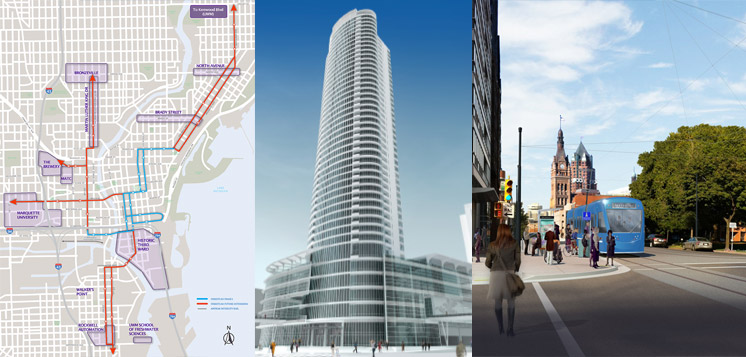
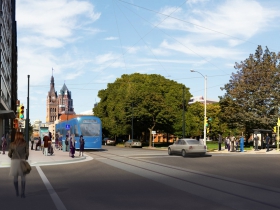
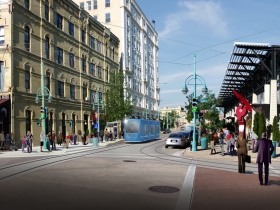
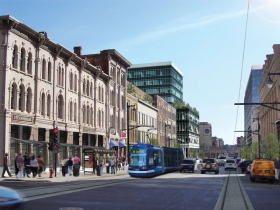
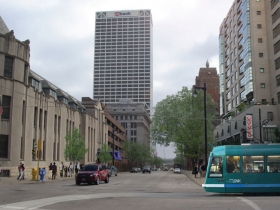
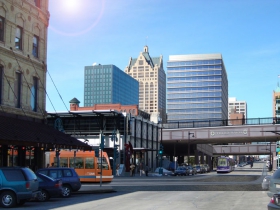
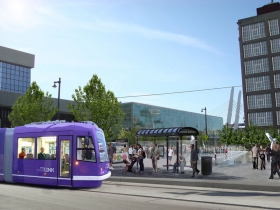
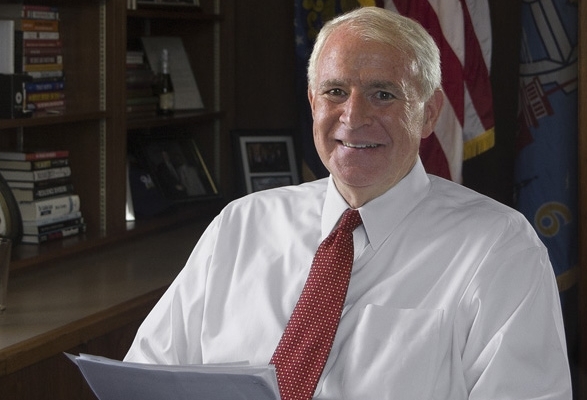




















It seems like only yesterday when a streetcar line was part of the proposal for improving the lakefront in time for Milwaukee’s 50th anniversary! (that was in 1898)
A “modern streetcar” network. Isn’t that considered an oxymoron? Like jumbo shrimp. Conservative pundits were right on, too when they said years ago, if this first line goes through, it will only lead to more wasted tax dollars on expanding this to other parts of the city and as the mayor says, to neighborhoods. $14 million dollars, that could do a lot more for the city than some outdated, boondoggle like this trolley system; like pay for more police officers. Oh, wait, I get it now. The mayor is a genius; if you build a trolley system, then no one will want to use a car to get around the city, thus taking away the allure of thieves to steal them. Very simple, no cars, no car thefts. How smart. What’s next? A city ordinance against driving in the city so you HAVE to buy a transit ticket? When I moved to Milwaukee they had just gotten rid of all the street cars and started tearing up the tracks left behind. They had electric wires spanning the areas above the streets so the city’s electric buses could propel themselves around town. They got rid of the electric buses, because they were limited to driving only on the wired streets. Now we are going back in time to using the most outdated mode of transportation ever built and using other people’s money to build it, which will eventually become a tax hell for citizens of Milwaukee and surrounding neighborhoods to deal with. Mayor Barrett, when was the last time you rode a city bus to work? Are you going to use your streetcar to get to work, or are you just another liberal that does what every other liberal does: “this is a good idea for you, people, but I will not participate. I’m above it.”
Yes life was so much better in 1950 Hal. You can’t declare something a failure when it hasn’t even been built. You sure are obtuse.
Wow. The fear expressed by Hal is really something, and it illustrates that almost complete loss of the commuter mentality in Milwaukee.
I’ve got to say as a paunchy, slightlly over-middle-aged white guy that I’ve enjoyed using Milwaukee’s public transportation since getting over my W’tosa-bred fear of it in the 1970s. I now wish I started using it 10 years earlier. Being transferred from a downtown Milwaukee office to a Waukesha County freeway ramp office park in the 1990s was a complete degredation to my quality of life as an east side Milwaukee homeowner.
It was pure heaven living in Chicago for a short time and using their multiple public transport. sytems even as my compact car was parked on the street. I know Milwaukeeans who break out in a sweat at the thought of that (will the car be safe at home? will the exterior remain clean?).
It remains astonishing to some of us that Milwaukee’s street car and interurban systems were dismantled.
The millennial that cuts my hair _refuses_ to believe that there was a fully operational public transportation system here linking southeastern Wisconsin’s towns and cities. Another one at a copy store told me that public transportation systems cause a loss of jobs. I forgot to ask if either of them enjoyed transportation options in any US or other cities around the world.
Actually, Hal, I know your diet is probably devoid of fish and seafood but there certainly are such things as jumbo shrimp. They’re called prawns.
To Hal: Weren’t the streetcars torn down right about the time when interstates became popular? My parents used the streetcars in Milwaukee daily and they, to this day, cannot figure out why Milwaukee caved in to the pressures of the newly built interstates and the popularity of a car. My Mother, age 70, has never driven a car in her life. And I suspect, my generation and the 20-somethings are a product of that generation. We do not want fancy cars with big, wide fancy interstates. And we also do not want gas guzzling, noisy, air-polluting buses all over the city, either. If you want that, then move to Atlanta.
Streetcars seem old-fashioned because they are so durable; they don’t break down and wear out like buses. Whereas a bus is discarded after 10–15 years of service, streetcars are sometimes good for 100 years.
Buses (and automobiles) seem so modern because they are really pieces of junk that fall apart within a decade or two and must be replaced with a new, shiny model. By contrast, streetcars last virtually forever.
In 2013, the average age of an active, in-service American bus was 7.6 years. If you assume that the average bus was halfway through its useful life, you come up with a useful life of 15.2 years for buses. By contrast, the average age of an active, in-service American streetcar (even with all the new streetcar systems coming on line) was 45.0 years, suggesting an average useful life of 90 years. (Source: 2013 National Transit Database)